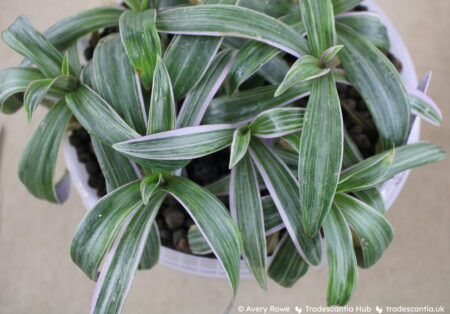Details
| Full name | Tradescantia spathacea ‘Sitara’. |
| Name status | Accepted, the valid name for a unique cultivar. Established with a description by Hatch (2022). Also known as:
The most widely-used established name, ‘Sitara’, is now accepted for this cultivar. |
| Origins | Origins recorded in a withdrawn application for plant breeder’s rights by Hansoti (2005). Discovered among unnamed Tradescantia spathacea plants in 2002 in India. Selected by Ashish Hansoti from Mumbai, India. Introduced by Ornamentex B.V. from ‘s-Gravenzande, the Netherlands. |
| Classification | The species Tradescantia spathacea is sometimes sold under its botanical synonyms Tradescantia discolor, Rhoeo spathacea, and Rhoeo discolor. |
| Legal protection | None. An application for plant breeder’s rights in the EU was withdrawn before the protection was granted (Hansoti, 2005). |
| Availability | Mass-produced and widely available around the world. |
Description
Preserved in a herbarium specimen (“Tradescantia spathacea ‘Sitara'”, 2023).
Described with reference to the RHS Colour Chart (6th Edition: 2019 reprint).
| Species | Tradescantia spathacea. |
| Growth habit | Compact, upright rosettes, which eventually trail as the stems get longer. |
| Foliage | Stems are 3-8mm wide, with internodes 1-3cm long, strong yellow green (144A) but usually covered up by overlapping leaf bases, completely hairless. Leaves are narrow with almost parallel sides, 6-15cm long and 1-2.5cm wide, completely hairless, with marginal variegation. The dark parts on the upper surface are a mixture of colours from dark yellowish green (139A) to greyish olive green (NN137C). The pale areas range from light purplish grey (N187D) to light purple (75A). The leaf undersides are dark purple (79A) to greyish reddish purple (N77C) under dark areas, and strong reddish purple (N78B) to strong purplish red (72A) under light areas. Sheaths range from light yellow green (138D) to greyish purplish red (N77D). |
| Flowers | Small white flowers tucked close to the stem, typical for the species. This cultivar flowers very rarely. |
References
Hansoti, A. (2005). Tradescantia spathacea ‘hansoti01’ [Netherlands plant breeder’s rights application TDC 8]. Raad Voor Plantenrassen.
Brickell, C. D., Alexander, C., Cubey, J. J., David, J. C., Hoffman, M. H. A., Leslie, A. C., Malécot, V., Jin, X. (2016). International Code of Nomenclature for Cultivated Plants. PDF link.
Hatch, L. (2022). Commelinaceae: A Guide to Modern and Historic Cultivars.
Tradescantia spathacea ‘Sitara’. (2023). [Herbarium specimen, barcode WSY0168566]. RHS Wisley Herbarium.




